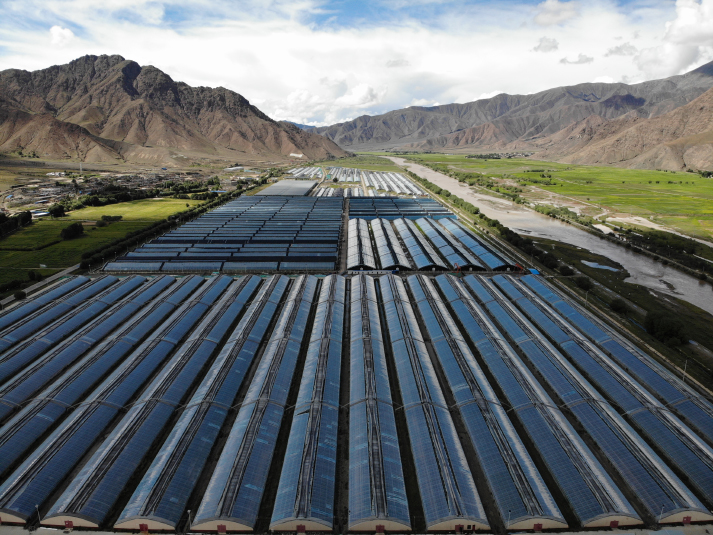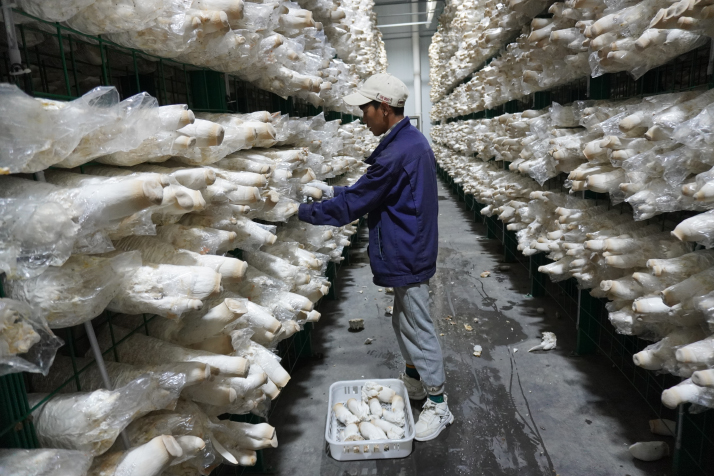| China |
| Modern agriculture improves lives and livelihoods in Tibet Autonomous Region | |
|
|
 A bird’s-eye view of the Zhufeng Modern Agricultural Expo Park in Bainang County, Xigaze, Tibet Autonomous Region, on August 16 (ZHANG WEI)
Till two years ago, Tenzin was a struggling farmer in Lungsang, a village in the city of Xigaze in Tibet Autonomous Region, southwest China. Lying at an average altitude of 4,000 meters, with long sunshine hours and fertile soil, the area is one of the region's major producers of highland barley. However, the crop had never brought the 75-year-old farmer any sizeable profit in his decades of farming. His family used it mostly to make tsampa, the traditional Tibetan staple food of roasted barley flour, and sold the rest. Selling was even harder than farming. Tenzin had to rent a truck to take the barley to nearby towns to sell it but would get only a little cash and sometimes, not even that but just sheepskin in barter. Then in 2016, a private company started up in the neighborhood. Tibet Deqin Sunshine Manor, seeing the potential in highland barley, which is rich in minerals and, among all kinds of wheat, has the highest beta-glucan—sugar content that improves the immunosystem—began to develop diverse barley products such as flour, noodles, biscuits and meal replacement powder, which appeal to non-Tibetan palates as well. "Our company is now the largest highland barley food processor in Tibet," Luo Hujie, director of the company's food factory, told Beijing Review. "To expand the market, we are working with research institutions such as the Tibet Academy of Agricultural and Animal Husbandry Sciences." Last year, the company's total sales through e-commerce platforms and offline stores amounted to over 20 million yuan ($2.9 million). Tibet Deqin Sunshine Manor signed contracts with farmers around Xigaze to buy their barley. In 2019, it purchased more than 3,000 tons of barley from them. Tenzin is among the sellers. He started selling his barley to the new company in 2018 in a win-win deal. The company sends trucks to the farmers to collect the grain while the local government gives them free fertilizer. In the past two years, Tenzin sold nearly 40 tons to the company at a price higher than the market price, making a total income of nearly 190,000 yuan ($27,566), which is an unprecedented windfall. "I and my family members used to harvest the barley in the past by ourselves," Tenzin said. "Now we hire a dozen hands since we are planting over a much larger area." Overlooked resource tapped Besides buying barley from the farmers, the company has created jobs for local people. According to Luo, they have more than 100 employees, with 64 of them working in the automated factory of Tibet Deqin Sunshine Manor. In 2019, the company provided training to 55 people from impoverished households and eventually employed four of them. The annual income of the employees is over 60,000 yuan ($8,738). In stark contrast, the annual income of villagers relying solely on farm work is around 5,000 yuan ($725) on average. Phurbu Tsering started working in the company in 2018 after he graduated from college. Following three months of training, he became a skillful operator and is now a team leader on the packaging line. "I earn 5,300 yuan ($770) per month. After I began to work here, my three-member family is no longer poor," the 28-year-old said. Villagers can also buy shares in the company, which earns them a dividend. In 2019, over 600 shareholders received about 2,700 yuan ($393) in dividends per family. To expand the industrial chain, the company is adding beer production. The new production lines are expected to process 100,000 tons of barley annually and create 50 more jobs. The byproduct from this, distillers grains, will be given to impoverished households to feed their cattle. Since the atmospheric pressure on the plateau is low, the factory needed to buy top-grade boilers to ensure the quality of the beer, Yi Huafeng, vice director of the factory, said. Creating vegetable baskets Modern agricultural technology has also contributed to improving the local people's diet. With the dry climate and huge day-and-night temperature difference affecting vegetable planting in Tibet, people in Bainang, a county in Xigaze, could grow only potato, turnip and Chinese cabbage in the past. In 2000, agricultural technicians from Shandong Province in east China arrived to teach Bainang farmers greenhouse planting adapted to the local climate and soil conditions. The county began to grow other vegetables including pepper and asparagus lettuce as well as fruits like watermelons. However, it was still not sufficient for locals to make a decent income since the area lacked strong and competitive vegetable enterprises that would buy their produce and create a niche market for them. By the end of 2015, the county still had 19.3 percent residents living in poverty. To develop the vegetable industry and alleviate poverty, the local government stepped in. They funded enterprises, announced preferential policies and encouraged collaboration between enterprises and research institutions to improve the product quality. Finally, the collective efforts paid off at the end of 2017, when Bainang was removed from the national list of poverty-stricken counties. By May this year, over 3,000 households were engaged in the vegetable industry, which had increased the annual income of each household by 30,000 yuan ($4,356) on average. It had also helped over 1,000 people shake off poverty. The Zhufeng Modern Agricultural Expo Park was built in Bainang in 2019, with the local government funding 35.9 million yuan ($5.2 million). The over 100-hectare park has eight glass greenhouses and 128 plastic ones and produces over 11,000 tons of fruits and vegetables per year on average. The annual output value is more than 50 million yuan ($7.2 million). Today, the park has become a major vegetable and fruit supplier for Xigaze and contributed to poverty alleviation in the area. It is also a major tourist attraction for leisure agriculture in Tibet, where tourists can go sightseeing and pay for picking fruits and vegetables. "Despite the novel coronavirus disease this year, the number of tourists rebounded during the May Day holidays," Meng Deli, the general manager of the company, said. "With around 1,000 visitors per day, the profits during the holidays, lasting for five days in this year, reached around 170,000 yuan ($24,764)." As of August, the park had 150 local employees. It had also trained 420 farmers as agricultural technicians. The average monthly salary of the employees is around 5,000 yuan, with free meals and accommodation. In addition, the park rents 100 hectares from nearly 2,000 people from impoverished households, which brings them a collective income of around 3 million yuan ($437,000) at the end of a year. The Xaitongmoin Biotech Demonstration Zone, a state-owned enterprise in Xaitongmoin, another county in Xigaze, is also a pioneer in vegetable planting. Xaitongmoin was among the last batch of counties and districts in Tibet to shake off poverty in 2019. The demonstration zone started operating the same year and now produces more than 10 types of edible fungi, including king oyster mushrooms and enoki mushrooms, which are sold across Xigaze and Lhasa. It collaborated with research institutions including Hunan Agricultural University and received support from the local government to address technological problems, including lack of electricity in the initial period. Today, its products have gone into mass production. In the first half of this year, it sold more than 700 tons of king oyster mushrooms, Huang Minfeng, deputy general manager of the company, told Beijing Review. Residues produced in the production process are used as biofuel. According to Huang, over 60 people from poor households have been employed this year. The demonstration zone also gives free fungi spawns to local farmers, buys their mushrooms and in addition, pays them a bonus from the profit it earns from selling their mushrooms. In the first half of the year, over 560 impoverished families were paid more than 3,000 yuan ($437) each as bonus. "In 2021, we plan to expand production, extend the industrial chains and increase the number of employees from 150 to 170," Huang said. "Also, we plan to involve more rural households in fungus planting."  A staff takes care of mushrooms in the Xaitongmoin Biotech Demonstration Zone in Xigaze, Tibet Autonomous Region on August 17 (LI XIAOYANG)
Different drivers Different areas in Tibet have been alleviating poverty effectively by developing different agricultural businesses, with some engaging in highland barley industries, some focusing on greenhouse vegetable planting, and some developing animal husbandry industries with partially automated production. The growth of high-quality agricultural and animal husbandry industries has resulted in Tibetans living better and eating better. According to the regional department of agriculture and rural affairs in February, Tibet produced around 1.05 million tons of grain last year, 970,000 tons of vegetables and 900,000 tons of meat and milk. Poverty alleviation programs embracing planting, animal husbandry and processing have seen 238,000 people shake off poverty while the income of more than 700,000 farmers and herdsmen has increased, the regional government said. (Reporting from Tibet Autonomous Region) (Print Edition Title: Harvesting a Better Future) Copyedited by Sudeshna Sarkar Comments to lixiaoyang@bjreview.com |
|
||||||||||||||||||||||||||||
|
